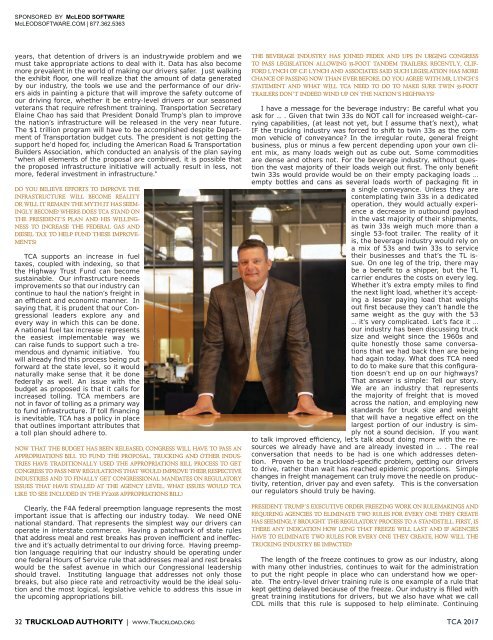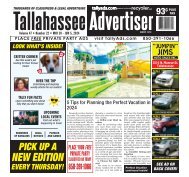TLA25_AllPages_R
You also want an ePaper? Increase the reach of your titles
YUMPU automatically turns print PDFs into web optimized ePapers that Google loves.
Sponsored by Mcleod software<br />
McLeodSoftware.com | 877.362.5363<br />
years, that detention of drivers is an industrywide problem and we<br />
must take appropriate actions to deal with it. Data has also become<br />
more prevalent in the world of making our drivers safer. Just walking<br />
the exhibit floor, one will realize that the amount of data generated<br />
by our industry, the tools we use and the performance of our drivers<br />
aids in painting a picture that will improve the safety outcome of<br />
our driving force, whether it be entry-level drivers or our seasoned<br />
veterans that require refreshment training. Transportation Secretary<br />
Elaine Chao has said that President Donald Trump’s plan to improve<br />
the nation’s infrastructure will be released in the very near future.<br />
The $1 trillion program will have to be accomplished despite Department<br />
of Transportation budget cuts. The president is not getting the<br />
support he’d hoped for, including the American Road & Transportation<br />
Builders Association, which conducted an analysis of the plan saying<br />
“when all elements of the proposal are combined, it is possible that<br />
the proposed infrastructure initiative will actually result in less, not<br />
more, federal investment in infrastructure.”<br />
Do you believe efforts to improve the<br />
infrastructure will become reality<br />
or will it remain the myth it has seemingly<br />
become? Where does TCA stand on<br />
the president’s plan and his willingness<br />
to increase the federal gas and<br />
diesel tax to help fund these improvements?<br />
TCA supports an increase in fuel<br />
taxes, coupled with indexing, so that<br />
the Highway Trust Fund can become<br />
sustainable. Our infrastructure needs<br />
improvements so that our industry can<br />
continue to haul the nation’s freight in<br />
an efficient and economic manner. In<br />
saying that, it is prudent that our Congressional<br />
leaders explore any and<br />
every way in which this can be done.<br />
A national fuel tax increase represents<br />
the easiest implementable way we<br />
can raise funds to support such a tremendous<br />
and dynamic initiative. You<br />
will already find this process being put<br />
forward at the state level, so it would<br />
naturally make sense that it be done<br />
federally as well. An issue with the<br />
budget as proposed is that it calls for<br />
increased tolling. TCA members are<br />
not in favor of tolling as a primary way<br />
to fund infrastructure. If toll financing<br />
is inevitable, TCA has a policy in place<br />
that outlines important attributes that<br />
a toll plan should adhere to.<br />
Now that the budget has been released, Congress will have to pass an<br />
appropriations bill to fund the proposal. Trucking and other industries<br />
have traditionally used the appropriations bill process to get<br />
Congress to pass new regulations that would improve their respective<br />
industries and to finally get Congressional mandates on regulatory<br />
issues that have stalled at the agency level. What issues would TCA<br />
like to see included in the FY2018 appropriations bill?<br />
Clearly, the F4A federal preemption language represents the most<br />
important issue that is affecting our industry today. We need ONE<br />
national standard. That represents the simplest way our drivers can<br />
operate in interstate commerce. Having a patchwork of state rules<br />
that address meal and rest breaks has proven inefficient and ineffective<br />
and it’s actually detrimental to our driving force. Having preemption<br />
language requiring that our industry should be operating under<br />
one federal Hours of Service rule that addresses meal and rest breaks<br />
would be the safest avenue in which our Congressional leadership<br />
should travel. Instituting language that addresses not only those<br />
breaks, but also piece rate and retroactivity would be the ideal solution<br />
and the most logical, legislative vehicle to address this issue in<br />
the upcoming appropriations bill.<br />
The beverage industry has joined FedEx and UPS in urging Congress<br />
to pass legislation allowing 33-foot tandem trailers. Recently, Clifford<br />
Lynch of C.F. Lynch and Associates said such legislation has more<br />
chance of passing now than ever before. Do you agree with Mr. Lynch’s<br />
statement and what will TCA need to do to make sure twin 33-foot<br />
trailers don’t indeed wind up on the nation’s highways?<br />
I have a message for the beverage industry: Be careful what you<br />
ask for … . Given that twin 33s do NOT call for increased weight-carrying<br />
capabilities, (at least not yet, but I assume that’s next), what<br />
IF the trucking industry was forced to shift to twin 33s as the common<br />
vehicle of conveyance? In the irregular route, general freight<br />
business, plus or minus a few percent depending upon your own client<br />
mix, as many loads weigh out as cube out. Some commodities<br />
are dense and others not. For the beverage industry, without question<br />
the vast majority of their loads weigh out first. The only benefit<br />
twin 33s would provide would be on their empty packaging loads …<br />
empty bottles and cans as several loads worth of packaging fit in<br />
a single conveyance. Unless they are<br />
contemplating twin 33s in a dedicated<br />
operation, they would actually experience<br />
a decrease in outbound payload<br />
in the vast majority of their shipments,<br />
as twin 33s weigh much more than a<br />
single 53-foot trailer. The reality of it<br />
is, the beverage industry would rely on<br />
a mix of 53s and twin 33s to service<br />
their businesses and that’s the TL issue.<br />
On one leg of the trip, there may<br />
be a benefit to a shipper, but the TL<br />
carrier endures the costs on every leg.<br />
Whether it’s extra empty miles to find<br />
the next light load, whether it’s accepting<br />
a lesser paying load that weighs<br />
out first because they can’t handle the<br />
same weight as the guy with the 53<br />
… it’s very complicated. Let’s face it …<br />
our industry has been discussing truck<br />
size and weight since the 1960s and<br />
quite honestly those same conversations<br />
that we had back then are being<br />
had again today. What does TCA need<br />
to do to make sure that this configuration<br />
doesn’t end up on our highways?<br />
That answer is simple: Tell our story.<br />
We are an industry that represents<br />
the majority of freight that is moved<br />
across the nation, and employing new<br />
standards for truck size and weight<br />
that will have a negative effect on the<br />
largest portion of our industry is simply<br />
not a sound decision. If you want<br />
to talk improved efficiency, let’s talk about doing more with the resources<br />
we already have and are already invested in … . The real<br />
conversation that needs to be had is one which addresses detention.<br />
Proven to be a truckload-specific problem, getting our drivers<br />
to drive, rather than wait has reached epidemic proportions. Simple<br />
changes in freight management can truly move the needle on productivity,<br />
retention, driver pay and even safety. This is the conversation<br />
our regulators should truly be having.<br />
President Trump’s executive order freezing work on rulemakings and<br />
requiring agencies to eliminate two rules for every one they create<br />
has seemingly brought the regulatory process to a standstill. First, is<br />
there any indication how long that freeze will last and if agencies<br />
have to eliminate two rules for every one they create, how will the<br />
trucking industry be impacted?<br />
The length of the freeze continues to grow as our industry, along<br />
with many other industries, continues to wait for the administration<br />
to put the right people in place who can understand how we operate.<br />
The entry-level driver training rule is one example of a rule that<br />
kept getting delayed because of the freeze. Our industry is filled with<br />
great training institutions for drivers, but we also have what we call<br />
CDL mills that this rule is supposed to help eliminate. Continuing<br />
32 Truckload Authority | www.Truckload.org TCA 2017

















